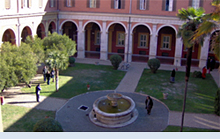 |
European Planetary Science Congress 2010
Angelicum Centre – Pontifical University of Saint Thomas Aquinas
19 – 24 September 2010, Rome, Italy |
 |
|
GP4 Giant Planet Systems and their Local Environments |
| Convener: Norbert Krupp | Co-Conveners: Leigh Fletcher , Pierre Drossart |
|
Oral Program
/ Fri, 24 Sep, 10:30–16:50
/ Room Aula Minor
Poster Program
/ Attendance Thu, 23 Sep, 17:30–19:00
/ Poster Area
|
Each of the four giant planets in our solar system exhibits a diverse suite of processes and environmental conditions, being distinct planetary systems in their own right. Each planet features a complex differentiated interior, a dynamically and chemically active neutral atmosphere, ionosphere and large magnetospheres, a highly variable ring system and a variety of moons. The planetary systems have distinct neutral and charged particle environments corotating around the planet, interacting with the rings and moons via tidal forcing and electrodynamical interactions. The configuration and the dynamics of those systems on a global and local scale are very complex and only partially understood. The thick Giant Planet atmospheres host complex physiochemical laboratories under the influence of vigorous dynamics, seasonal variations in energy deposition and are partly driven by their interaction with the magnetospheres and space environment. The systems demonstrate variability over a range of timescales, from rapid evolution (asteroidal/cometary impacts) to decadal changes (seasonal evolution). Over the past decades these systems have been explored in-situ by spacecraft during flybys and in orbit, remotely by ground- and Earth-orbit based observations, with theory and model studies helping to better understand the processes involved.
This session encompasses observations, theories and modeling of physical processes in giant planet systems and the interactions with their local environments. It also addresses the coupling processes between the magnetospheres and atmospheres/ionospheres, exospheres, and the solar wind.
Contributions discussing important scientific targets, analytical techniques and numerical simulation with relevance to the upcoming Europa-Jupiter System Mission are particularly welcome.

